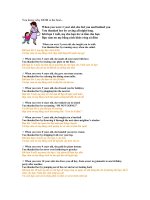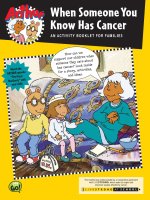So when someone says “adapter” you know what they mean
Bạn đang xem bản rút gọn của tài liệu. Xem và tải ngay bản đầy đủ của tài liệu tại đây (73.2 KB, 13 trang )
Review: Design Pattern Structure
• A design pattern has a name
– So when someone says “Adapter” you know what they mean
– So you can communicate design ideas as a “vocabulary”
• A design pattern describes the core of a solution to a
recurring design problem
– So you don’t have to reinvent known design techniques
– So you can benefit from others’ (and your) prior experience
• A design pattern is capable of generating many
distinct design decisions in different circumstances
– So you can apply the pattern repeatedly as appropriate
– So you can work through different design problems using it
CSE 332: Design Patterns
Three Design Patterns Involving Classes
• Adapter (structural)
– Converts an interface you have into one you want
• Memento (behavioral)
– Externalizes the state of an object
• Observer (behavioral)
– Tells objects about changes in another object
CSE 332: Design Patterns
Structural Patterns
• Help define fixed structural relationships
– Between classes, and their associations
• Emphasis on the class diagrams
• Example
– Adapter pattern
CSE 332: Design Patterns
Inconsistent Interfaces
• Challenge
– Different code bases are often written by different
developers, at different times, with different design goals
– Interfaces expected by one piece of code are not always the
same as those provided by the other code that’s available
• Motivates use of the Adapter pattern
– Provides a class that exposes the interface that’s needed
– That interface is implemented using calls to methods of the
existing object(s)
A related pattern called Wrapper Faỗade provides a similar
capability by wrapping functions (e.g., socket calls, etc.)
CSE 332: Design Patterns
Adapter Pattern
• Problem
– Have an object with an interface that’s close to (but
is not exactly) what we need
• Context
– Want to re-use an existing class
– Can’t change its interface
– It’s impractical to extend class hierarchy more
generally
• Solution Core
– Wrap a particular class or object with the interface
needed (2 forms: class form and object forms)
CSE 332: Design Patterns
Adapter Structure (Class Form)
Interface
Impl
method () = 0;
impl_method ();
private
public
Adapter
method () {
impl_method ();
};
• Interface abstract base class provides desired
interface
• Impl concrete class provides the implementation
• Adapter glues them together via inheritance
CSE 332: Design Patterns
Adapter Structure (Object Form)
Interface
method () = 0;
impl_
Adapter
Impl
impl_method ();
method () {
impl_->impl_method();
};
• Interface abstract base class provides desired
interface
• Impl concrete class provides the implementation
• Adapter glues them together via delegation
CSE 332: Design Patterns
Behavioral Patterns
• Help define dynamic behavioral relationships
– Between objects at run-time
• Emphasis is on interactions among objects
• Examples
– Memento pattern
– Observer pattern
CSE 332: Design Patterns
Adding State Persistence
• Challenge
– Want to save and restore an object’s state
– For example, between different runs of a program
• Motivates use of the Memento pattern
–
–
–
–
Serialize an object’s state into an opaque “cookie”
Format of cookie can be tailored to storage format
Can send it to a file, a caretaker object, another computer
Can reconstitute object from its memento later/elsewhere
CSE 332: Design Patterns
Memento Pattern
• Problem
– Want to externalize state of an object without violating
encapsulation
• Context
– A snapshot of object state is needed
– Providing a state interface would violate encapsulation
• Solution Core
– Create a memento class with methods to get, set state
– Provide an opaque representation of state itself
• Consequences
– Can use memento to send object state over a socket,
save it in a file, put it into a checkpoint/undo stack, etc.
CSE 332: Design Patterns
Inter-dependent Object Behaviors
• Challenge: need to coordinate object state changes
– For example, a sensor may record current temperature
– Other objects (e.g., thermostat) need to know when the
temperature changes
• Motivates use of the Observer pattern
– Helps to keep objects mostly independent
– Separates registration, notification, and actions
– But, still allows appropriate coordination among objects
CSE 332: Design Patterns
Observer Pattern
• Problem
– Need to update multiple objects when the state of one
object changes
• Context
– Multiple objects depend on the state of one object
– Set of dependent objects may change at run-time
• Solution core
– Allow dependent objects to register with object of interest,
notify them of updates when state changes
• Consequences
– When observed object changes others are notified
– Useful for user interface programming, other applications
CSE 332: Design Patterns
Observer Pattern Behavior
<<Subject>>
<<Observer>>
<<Observer>>
register()
register()
(optional)
∆ state
notify()
update()
update()
CSE 332: Design Patterns









